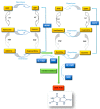Purine Metabolism Dysfunctions: Experimental Methods of Detection and Diagnostic Potential
- PMID: 37108190
- PMCID: PMC10138451
- DOI: 10.3390/ijms24087027
Purine Metabolism Dysfunctions: Experimental Methods of Detection and Diagnostic Potential
Abstract
Purines, such as adenine and guanine, perform several important functions in the cell. They are found in nucleic acids; are structural components of some coenzymes, including NADH and coenzyme A; and have a crucial role in the modulation of energy metabolism and signal transduction. Moreover, purines have been shown to play an important role in the physiology of platelets, muscles, and neurotransmission. All cells require a balanced number of purines for growth, proliferation, and survival. Under physiological conditions, enzymes involved in purines metabolism maintain a balanced ratio between their synthesis and degradation in the cell. In humans, the final product of purine catabolism is uric acid, while most other mammals possess the enzyme uricase that converts uric acid to allantoin, which can be easily eliminated with urine. During the last decades, hyperuricemia has been associated with a number of human extra-articular diseases (in particular, the cardiovascular ones) and their clinical severity. In this review, we go through the methods of investigation of purine metabolism dysfunctions, looking at the functionality of xanthine oxidoreductase and the formation of catabolites in urine and saliva. Finally, we discuss how these molecules can be used as markers of oxidative stress.
Keywords: allantoin; purine metabolism; uric acid; xanthine.
Conflict of interest statement
The authors declare no conflict of interest.
Figures


Similar articles
-
Regulation of uric acid metabolism and excretion.Int J Cardiol. 2016 Jun 15;213:8-14. doi: 10.1016/j.ijcard.2015.08.109. Epub 2015 Aug 14. Int J Cardiol. 2016. PMID: 26316329 Review.
-
New insights into purine metabolism in metabolic diseases: role of xanthine oxidoreductase activity.Am J Physiol Endocrinol Metab. 2020 Nov 1;319(5):E827-E834. doi: 10.1152/ajpendo.00378.2020. Epub 2020 Sep 7. Am J Physiol Endocrinol Metab. 2020. PMID: 32893671 Review.
-
Purine degradation in Pseudomonas aeruginosa and Pseudomonas testosteroni.Biochim Biophys Acta. 1977 Aug 25;499(1):111-8. doi: 10.1016/0304-4165(77)90233-1. Biochim Biophys Acta. 1977. PMID: 407941
-
Enzymes involved in purine metabolism--a review of histochemical localization and functional implications.Histol Histopathol. 1999 Oct;14(4):1321-40. doi: 10.14670/HH-14.1321. Histol Histopathol. 1999. PMID: 10506947 Review.
-
Arxula adeninivorans xanthine oxidoreductase and its application in the production of food with low purine content.J Appl Microbiol. 2013 Sep;115(3):796-807. doi: 10.1111/jam.12284. Epub 2013 Jul 8. J Appl Microbiol. 2013. PMID: 23773263
Cited by
-
The Results of the URRAH (Uric Acid Right for Heart Health) Project: A Focus on Hyperuricemia in Relation to Cardiovascular and Kidney Disease and its Role in Metabolic Dysregulation.High Blood Press Cardiovasc Prev. 2023 Sep;30(5):411-425. doi: 10.1007/s40292-023-00602-4. Epub 2023 Oct 4. High Blood Press Cardiovasc Prev. 2023. PMID: 37792253 Free PMC article. Review.
-
Clinical outcomes in patients with cardiorenal multimorbidity: the role of serum uric acid/serum creatinine ratio.High Blood Press Cardiovasc Prev. 2025 Mar;32(2):209-216. doi: 10.1007/s40292-025-00706-z. Epub 2025 Mar 4. High Blood Press Cardiovasc Prev. 2025. PMID: 40035942 Free PMC article.
-
Multi-level regulation of hindgut homeostasis by volatile fatty acid administration in dairy goats: linking microbial metabolism to epithelial inflammation and barrier function.mSystems. 2025 Jul 22;10(7):e0011625. doi: 10.1128/msystems.00116-25. Epub 2025 Jun 13. mSystems. 2025. PMID: 40511946 Free PMC article.
-
Hyperuricemia and its related diseases: mechanisms and advances in therapy.Signal Transduct Target Ther. 2024 Aug 28;9(1):212. doi: 10.1038/s41392-024-01916-y. Signal Transduct Target Ther. 2024. PMID: 39191722 Free PMC article. Review.
-
Effect on consumers' sustainable purchase intention of dietary supplement purine labeling.Front Nutr. 2025 Jun 4;12:1526713. doi: 10.3389/fnut.2025.1526713. eCollection 2025. Front Nutr. 2025. PMID: 40535036 Free PMC article.
References
-
- García-Nieto V.M., Claverie-Martín F., Moraleda-Mesa T., Perdomo-Ramírez A., Tejera-Carreño P., Cordoba-Lanus E., Luis-Yanes M.I., Ramos-Trujillo E., RenalTube Group Gout associated with reduced renal excretion of uric acid. Renal tubular disorder that nephrologists do not treat. Nefrología (Engl. Ed.) 2022;42:273–279. doi: 10.1016/j.nefroe.2022.05.007. - DOI - PubMed
Publication types
MeSH terms
Substances
LinkOut - more resources
Full Text Sources

